Quantities, Symbols, and Units in Spectroscopy
A reminder of what certain terms mean and how they should be used in scientific work

The two international governing bodies that impact spectroscopy are the International Union of Pure and Applied Physics (IUPAP) and the International Union of Pure and Applied Chemistry (IUPAC). In this installment, we take a look at the various terms that have come out of these bodies. Spectroscopists are probably well aware of these naming conventions, but this column can serve as a reminder of what certain terms mean and how they should be properly used in scientific work.
The two international governing bodies that impact spectroscopy are the International Union of Pure and Applied Physics (IUPAP) and the International Union of Pure and Applied Chemistry (IUPAC). IUPAP was organized in 1922 and began meeting to formalize physics standards worldwide the next year. It is organized into commissions, and one that concerns us here is the Commission on Symbols, Units, Nomenclature, Atomic Masses & Fundamental Constants (SUNAMCO). IUPAC was formed in 1918, but actually has its roots in a meeting in 1860 organized by Kekulé (of benzene fame) that was held to standardize organic chemical nomenclature. The efforts of IUPAC's Interdivisional Committee on Terminology (ICTNS) concern us here.
In this installment, we consider the conventions. I do not mean the gatherings of people in hotels or meeting centers to meet and exchange information, but rather the agreed-upon quantities, symbols, and units that experts in a field use to communicate their ideas.
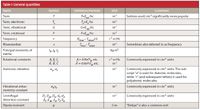
Table I: General quantities
Let's be honest, some conventions are arbitrary and whimsical (remember the story of the unit "barn" for nuclear cross sections?). Some conventions become issues of national pride (think: naming new chemical elements) while some have little provenance other than long-term historical use (think: candela). But understanding and using the proper conventions is fundamentally important to properly communicating ideas, especially technical ideas like spectroscopy. That is one reason that instruction in proper conventions is a crucial part of educating new scientists and technicians.
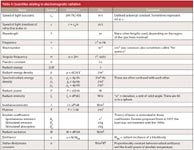
Table II: Quantities relating to electromagnetic radiation
All fields have conventions. For example, what is a language but an agreed-upon convention for making sounds? Postal delivery may not seem like a highfalutin' profession, but there are conventions to writing and interpreting delivery addresses that must be mastered to be a competent postal delivery person. Here, we will review some of the conventions for the quantities that are used in spectroscopy, along with their units and the occasional definition.
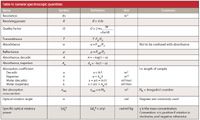
Table III: General spectroscopic quantities
Keepers of the Quantities, Symbols, and Units
The organizations that promote the conventions of spectroscopy are the IUPAC and IUPAP with units ultimately approved by SystÈme international d'unités (that is, the SI system of units). IUPAC has the more concise presentation, published in its "Green Book": Quantities and Symbols in Physical Chemistry (1), which was last issued in 2008. Section 2.6 of that tome lists the various conventions for naming and symbolizing quantities involved in spectroscopy, as well as the recommended SI unit (although occasionally other units are more popular, like cm-1 for wavenumber). These are the conventions that spectroscopists are expected to follow so they can communicate properly with other spectroscopists. In constructing this document, IUPAC included recommendations from IUPAP (2), the ICSU Joint Commission on Spectroscopy, and common practices in spectroscopy at the time (see references 27–31 in reference 1).
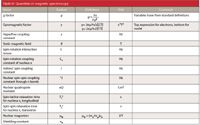
Table IV: Quantities in magnetic spectroscopy
In Tables I–V, most of the information has been taken from reference 1. It is assumed that the reader knows the symbols of the various units, both basic and derived. If units are not given, it is understood that the value is unitless. Comments, if present, are my own.
Spectroscopists, take note: These are your conventions. Use them among yourselves and teach them to others. We'll all communicate better that way.
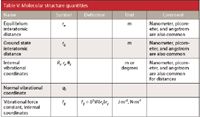
Table V: Molecular structure quantities
References
(1) E.R. Cohen, T. Cvitas, J.G. Frey, B. Holmström, K. Kuchitsu, R. Marquardt, I. Mills, F. Pavese, M. Quack, J. Stohner, H.L. Strauss, M. Takami, and A.J. Thor in IUPAC's "Green Book": Quantities and Symbols in Physical Chemistry, 3rd Edition, 2nd Printing (IUPAC & RSC Publishing, Cambridge, UK, 2008).
(2) E.R. Cohen and P. Giacomo, Symbols, Units, Nomenclature and Fundamental Constants in Physics, Document IUPAP-25, 1987; also published in Physica146A, 1–67 (1987).
David W. Ball is a professor of chemistry at Cleveland State University in Ohio. Many of his "Baseline" columns have been reprinted as The Basics of Spectroscopy, available through SPIE Press. Professor Ball sees spectroscopy from a physical chemistry perspective, because that's his background. He recently served as Distinguished Visiting Professor at the US Air Force Academy, but is now back home in Ohio. He can be reached at d.ball@csuohio.edu.

David W. Ball
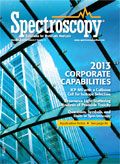
New Study Provides Insights into Chiral Smectic Phases
March 31st 2025Researchers from the Institute of Nuclear Physics Polish Academy of Sciences have unveiled new insights into the molecular arrangement of the 7HH6 compound’s smectic phases using X-ray diffraction (XRD) and infrared (IR) spectroscopy.
Best of the Week: Multidimensional Mass Spectrometry, Exoplanet Discovery, LIBS Plasma Behavior
March 28th 2025Top articles published this week include a long-form video interview from the American Academy of Forensic Sciences (AAFS) Conference, as well as several news articles highlighting studies where spectroscopy is being used to advance space exploration.
Microplastics Widespread on Catalan Beaches, Study Finds
March 28th 2025In a recent study published in Marine Pollution Bulletin, a team of researchers from several Spain and Portugal universities and institutions (Rovira i Virgili University, Universitat de Barcelona, University of Porto, and Institut d'Investigació Sanitaria Pere Virgili (IISPV) assessed microplastic (MP) contamination along the Mediterranean coastline.